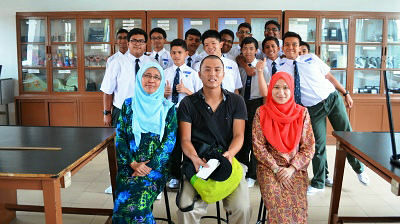Three African schools whose former teachers were astounded, including English education advanced from Japan

What kind of image will you hold when you hear that it is an African school? Wooden school building standing in the grass ... ...? No way. In some cases, it can be said that Japan is taking a delay.
Hello! A traveler tells the worldWorld newspaperA special reporterTaira Hiroyukiis. I am now in Sweden (star) in Scandinavia (the red line is overland, the blue line moves on the air route). I stayed in East Africa for two months until the end of the year.
Before I left I was a science teacher at a middle and high school. Therefore, one theme of traveling is "to visit overseas junior high and high school." Its purpose is to "obtain a new lesson method", "know the characteristics of overseas schools" "know the realities of national students" "compare club activities with Japan".
Each of the three schools posted this time has permission to photograph coverage, and also has interviews with the students. Up to now I posted two articles on the summary of schools in Asia, the summary of schools in India, the Middle East and Eastern Europe.
Asia's junior high school / six high schools that astonished former teachers - GIGAZINE
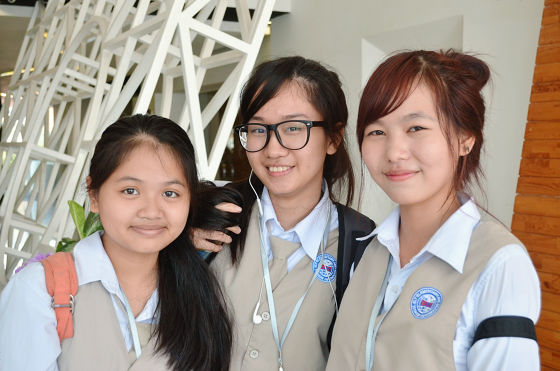
Four overseas schools whose former teachers were surprised such as Mammoth school with 50,000 students - GIGAZINE

◆ Chalk flies, Ethiopia's 65-class class
EthiopiaOkay.JinmaI visited the public Jiren Secondary School at Even though it is a secondary school, it is a high school in Japan of 15 to 18 (9, 10, 11, 12). Tuition is free.

There was no such thing as a big school building, and about 10 buildings like pictures were set up in the premises, which became a classroom.

This is schedule. If you look closely, the sixth hour is over before 12 o'clock. The reason is due to the large number of students. Since the first year is a huge number of people with about 1,300 people, it is a two-part system in the morning and afternoon. I was going to school in exchange with my brother. Incidentally, the upper right part is "2007", but since it is a unique calendar called Ethiopian history, it is not a mistake.
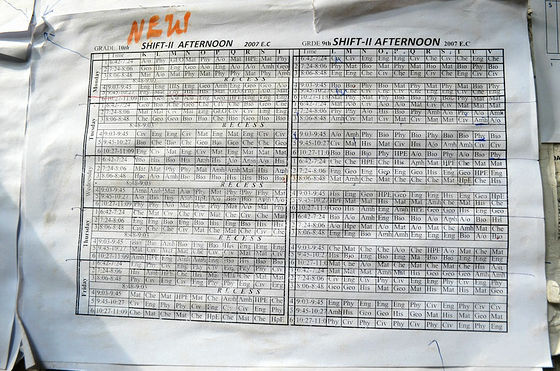
It is a state of the classroom. People in Ethiopia can look into the pictures. Girls ratio is 4: 6 and girls are many. In Africa, I was a little surprised, as girls still had prejudice that they are hard to go to school because of home help etc.
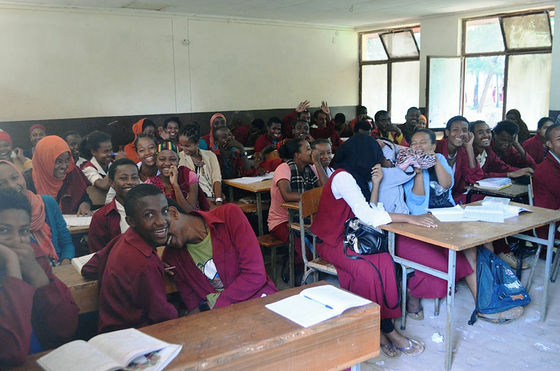
This is a 9th grade (junior high school junior high school student in Japan) chemistry class. I taught it in English. It is said that all subjects will be taught in English. Even in Africa, I felt the disparity between English education and Japan. There are 65 people in this class. It is about twice the number of Japan.

For this reason, three people sat on a desk for two people, and the note seemed to be hard to get away. Our teacher said that it was difficult to grasp the understanding of 65 students. However, for students who were noisy even a little, I threw chalk and put together classes.
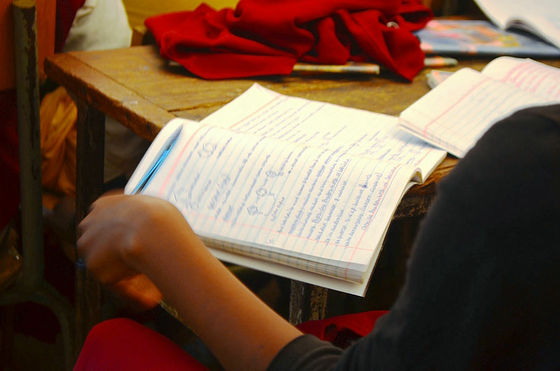
The classroom was more beautiful than I thought, but when I look closely it was full of holes in the floor.

Students are seriously serious. Everyone positively answered the teacher 's question. Even after the lesson I asked a question.
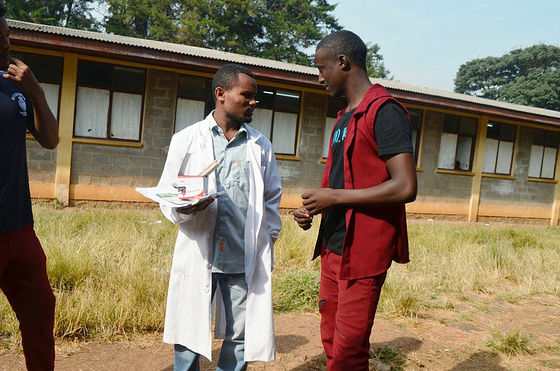
Bruk Abarah on the right is a ninth grader (15 years old) and he is good at mathematics and he said he would like to become a technician in the future. It seems that home helps after school.
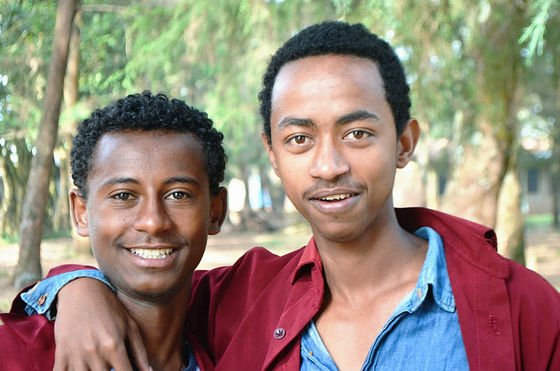
Professor Kohe taught me. Ethiopian education seems to have adopted the American, Italian and British methods until 1996. However, I wanted to shift the main industry from primary to secondary, so I started to model Chinese and Indian education. Specifically, we have established an educational institution to promote technology such as training schools. And in the 11th to 12th grade only the top 20 percent of the top grades entered the university, and the other students seem to be going to the training school.
Again, I was shocked that 65 classes per class. The fatigue of the teacher who summarizes it is immeasurable. Moreover, because there is a shortage of science science teachers, it seems that they are out for class in the afternoon in the morning. Even so, the monthly salary is less than $ 200 (about 23,500 yen).
◆ Schools in Malawi where special classes are enriched
MalawiOkay.MuzimbaWe visited the public · Mzimba Secondary School in This also corresponds to high school in Japan where 15 to 18 years old goes through. The tuition was 500 kwacha (about 125 yen) in 3 months.

The students here live in the dormitory. Like the Ethiopia school building, several huts were set up on the premises. The sky of Malawi was a picturesque blueness.

The day we had a trip was during the exam before the winter vacation. According to the story of the school officials, it was said that there were 90 classes in a class, although we could not tour in the classroom. It is more than Ethiopia.

This is the itinerary of the exam. The rest time is conspicuous in some places. Are there classroom and personnel shortage? "LIFE SKILLS" seems to be a subject to learn means to protect themselves from infectious diseases such as HIV. Malawi, Wikipedia'sArticle on "HIV / AIDS in Malawi", "It is clear that about 14.1% of adults between the ages of 15 and 49 are infected with HIV and one of the regions where HIV / AIDS is the most prevalent in the world" It is being done.

The exam question had different answer time for each subject. This is a test of "agriculture". Time is entered in the upper right. It is 1 hour 30 minutes.

This is an English test. It is 1 hour and 10 minutes. I showed other subjects, but except in my mother tongue, problems were made in English.

This is a picture of the chemical store in the chemical laboratory. At first glance it looks abundant, but none of them were too old to use, saying that the government would buy it after 4.5 years. Chemistry and physics were taught together as one subject. However, it seems to teach them separately from next year following industrialized countries.

At schoolJICAI was able to see the support mark of. Malawi is also known as a country with many young Overseas Cooperation Volunteers. It seems that this mat is also provided by JICA. A Japanese teacher of mathematics was dispatched in 1978. About 40 years ago I was admired by the courage to step into the land of Africa.

There was a special class in this school. Eighteen children with visual and hearing impairments were under test. Equipment for them, such as a printing machine for Braille as shown in the photograph, was solid. It seems that the Nordic countries are supporting it.

Here is a note written in braille. Braille is struck below the letters.
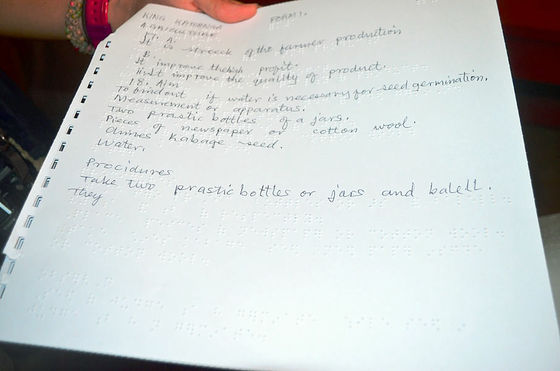
On the left she is 15 years old (first grade) Mr. Win. He was good at English, and after school he was joking when he was constantly eating Malawi's staple food, Shima (corn flour paste). The dream seems to have not been decided yet.

Shamefully, I did not assume that there is an environment for disabled students in Africa. Three of the special classes were albino students. What is Albino?Diseases in which body hair and skin turn white due to lack of melaninis. The roots of albino are considered East Africa, and there are many things to see even if you are walking in the city. I hope that special class support including them will be maintained throughout Africa.
◆ All you can eat mango, Zambian science love school
ZambiaSo, we visited the public David Livingstone Secondary School of Livingstone, one of the world 's three largest waterfalls, with Victoria Falls. This is a combination of junior high school and high school in Japan that ages 14 to 18 (8th graders to 12th graders) pass.

Green on the premises was overflowing and there were many vertically oriented shops that were like other countries. There seems to be no concept of school building like Africa.
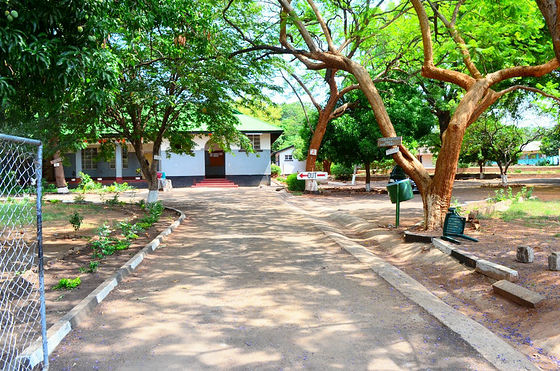
I found a signboard warning about AIDS. This is one of AIDS-rich countries.
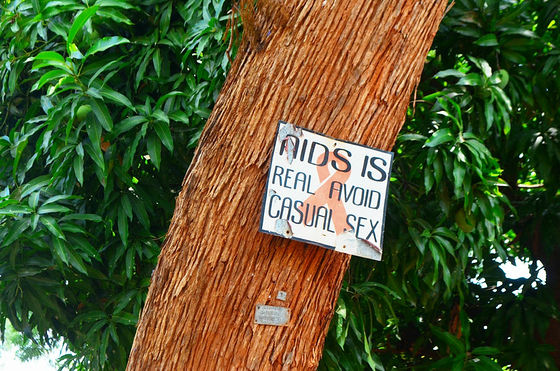
Despite being a winter holiday when I let you visit, the students have been studying voluntarily for the test of the New Year.
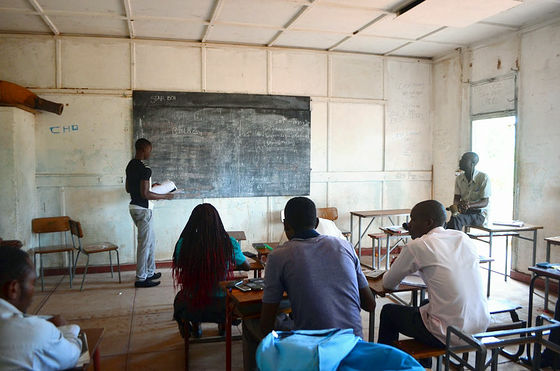
There was also a winter course. This is that classroom.
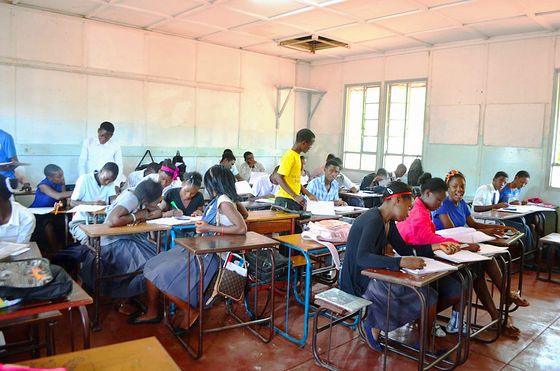
In Livingston I see a mango tree in town. Of course the school building was full of mango trees. The mango is in saturation. The students dropped fruit and was hanging in the school building.
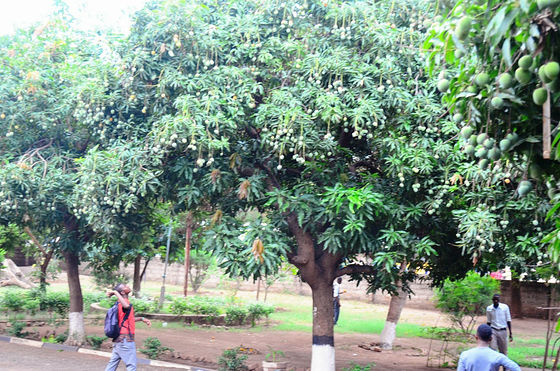
I got two small enough (laugh)
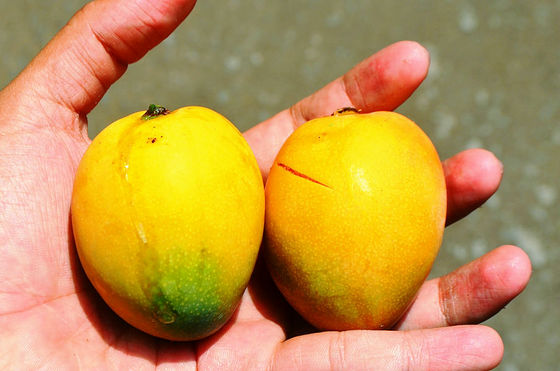
The right student is 17-year-old (11th grade) Keit. He is good at physics and chemistry, and he seems to want to become an engineer in the future. I am studying after school.
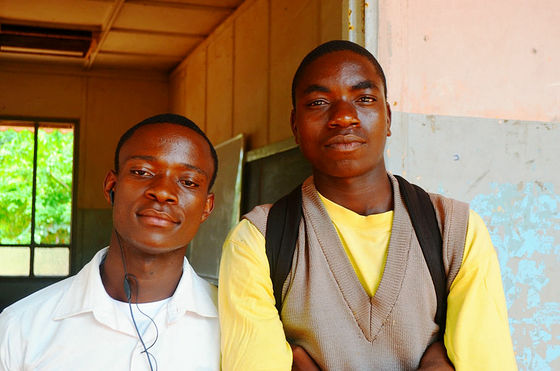
I interviewed four students here, but all the answers to "After school" were "studying" by all. Moreover, he was good at science in order to get a job in science such as nurse and engineer. Would it be like this if you interviewed in Japan?
◆ Summary
Wooden school building with no windows, standing in the grass. This was my African school which I imagined. However, even in cities that are not actually familiar, the educational curriculum and facilities were firmer than they thought.
I was particularly surprised that "Enhancement of English education" and "There are many students who like science". At first, I felt worried that the French image was strong, but as in all classes and tests being done in English, I was hardly in English in East Africa. Regardless of the past visits to schools, there are so many countries that Japanese classes in English are taught in their mother tongue.
Also, when I tell you that there are many students who do not like science in science and technology countries like Japan, they are always said to be "kidding". It seems that it is caused by the high salary of the science professions, but when I look at the student who is proudly saying "I love physics and chemistry", I felt the reliability of playing the future.
My trip also lasts two months, and at the end I want to deliver the state of the school in Central America and South America.
Statement · Interview: Koji Tsuyoshihttp://zoshiki.com/wp/
Supervision: World newspaperSekaishinbun.net

Related Posts:
in Coverage, Posted by logc_nt
